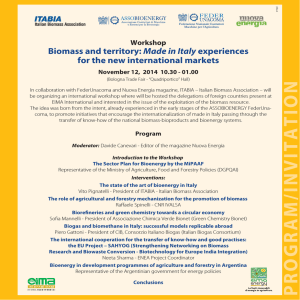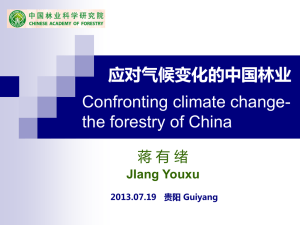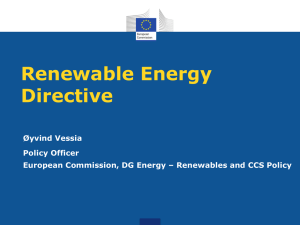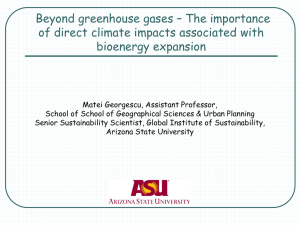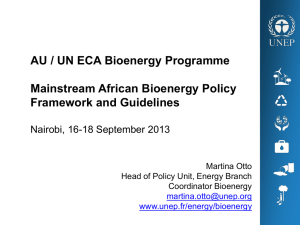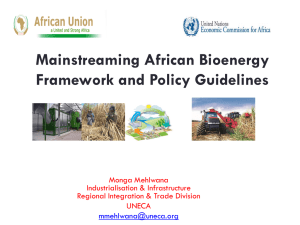Task 43: Sustainability Criteria For International Trade in Wood Pellets
advertisement
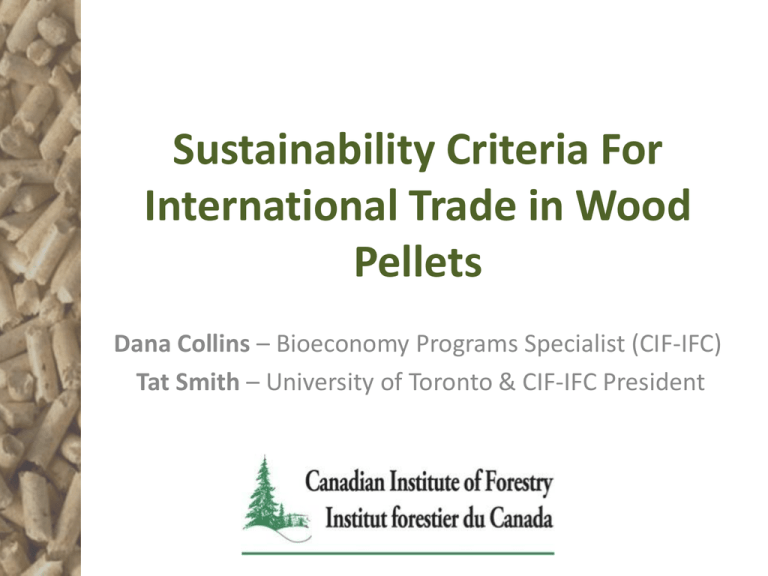
Sustainability Criteria For International Trade in Wood Pellets Dana Collins – Bioeconomy Programs Specialist (CIF-IFC) Tat Smith – University of Toronto & CIF-IFC President Outline • Drivers for Forest Bioenergy • Outcomes of European Climate Mitigation and Bioenergy Policies • Sustainability Governance – Standards, Policies and Certification • Implications of Multiple Levels of Governance on Forest Management and Trade • The Role of IEA Bioenergy Task 43 and the Canadian Institute of Forestry • Recommendations and Take-Home Questions 2 Drivers For Forest Bioenergy • • • • • Climate Change Diversification of forest sector Reduce forest stresses Bioeconomy opportunities Value for ecological services 3 Indicators of a Changing Global Climate http://www.climatechange2013.org/ 4 What Role Can Forests Play? « In the long term, sustainable forest management strategies aimed at maintaining or increasing forest carbon stocks, while producing a sustained yield of timber, fibre, or energy from the forest, will generate the largest sustained mitigation benefit. » IPCC 2007 ch 9: Forestry, AR4, Group III 5 Major opportunities facing NA forest Sector: • Develop renewable energy sector • Realize benefits to economy, environment and society Martin Holmer, 2001 6 CHP Direct LVL large SPF East large SPF East medium Nexterra Syngas dryer LVL Small NBSK + H&P Large OSB large NBSK + H&P Medium OSB medium Pellets East large SPF East small MDF NBSK + H&P Small NBHK + H&P Large OSB small LWC NBHK + H&P Medium Particle Board Pellets East medium Pellets East small SPF East Large + Pellets Large SPF East Large + Pellets small Source: FPAC 2010. BCTMP + H&P Medium NBHK + H&P Small Power Direct OSL Newsprint What Technologies will Attract Capital? 60% 50% 40% 30% 20% 10% 0% -10% -20% 7 Gt CO2 GHG Reduction Strategies 60 55 Baseline emissions 57 Gt CCS 19% 50 Renewables 17% 45 40 Nuclear 6% 35 Power generation efficiency and fuel switching 5% End-use fuel switching 15% 30 25 20 15 End-use fuel and electricity efficiency 38% BLUE Map emissions 14 Gt 10 5 WEO 2009 450 ppm case ETP2010 analysis 0 2010 2015 2020 2025 2030 2035 2040 2045 2050 Source: OECD/IEA 2010 • Need a global 50% CO2 cut by 2050 • Various technologies are needed to reduce energy-related CO2 emissions • EU has tackled this challenge with substantial goals 8 Outline • Drivers for Forest Bioenergy • Outcomes of European Climate Mitigation and Bioenergy Policies • Sustainability Governance – Standards, Policies and Certification • Implications of Multiple Levels of Governance on Forest Management and Trade • The Role of IEA Bioenergy Task 43 and the Canadian Institute of Forestry • Recommendations and Take-Home Questions 9 Increased Demand Brings New Challenges & Opportunities • Current bioenergy – Modern bioenergy: 10-15 EJ/year – Total bioenergy: 50 EJ/year • Deployment level of IPCC scenarios by 2050 – 440-600 ppm CO2eq target: 80-150 EJ/year – <440 ppm CO2eq target: 118-190 EJ/year • Current production of other biomass – Industrial roundwood: around 15 EJ/year – Major agricultural crops: about 60 EJ/year – Is a 10-fold increase possible and sustainable? 10 Wood Pellet Consumption in Europe Source: WPAC11 Increased Demand for Wood Pellets 12 Traditional Forest Products Markets Dominate Bioenergy remains a marginal, residual (mill & harvest) assortment STUMPS 3 Potential 60 - 80 m For energy 50 - 60 m3 STAND: 3 Round wood 250 m Forest residues 100 m3 At least one third of the logging residues and stumps will be left in the forest as a fertiliser 1 hectare HARVESTING ROUND WOOD WITH BARK 1 m3= 2,5 i-m3 FOREST RESIDUES 250 m3 40 - 60 m3 Bark, sawdust and other wood residues 3 SAWMILL/PULP MILL 190 - 210 m E.Alakangas Wood fuel TOTAL WOOD FUELS 150-180 m3 = 300 - 360 MWh Heat production = 170 - 200 MWh Electricity production = 85 - 100 MWh 13 Total Volume and Source of Forest Energy Must Change < 5 TWh Recycled wood Forest sector > 50 TWh ~ 3 TWh Imports 0.7 TWh Thinning Residues 4.4 TWh Chipwood 1 TWh By-products 5 TWh Black liquor, Pine oil > 35 TWh Source: Björheden, 2004 14 Outline • Drivers for Forest Bioenergy • Outcomes of European Climate Mitigation and Bioenergy Policies • Sustainability Governance – Standards, Policies and Certification • Implications of Multiple Levels of Governance on Forest Management and Trade • The Role of IEA Bioenergy Task 43 and the Canadian Institute of Forestry • Recommendations and Take-Home Questions 15 Relevant EU Legislation • Emission Trading System (ETS) of 2005: • Carbon cap-and-trade system for EU • Biomass co-firing considered C-neutral • 2013: adding aviation sector, introducing auctioning of allowances • Criticisms: price of C is too low, biomass shouldn’t be considered C-neutral • Energy Efficiency Directive (2011): • Encourages CHP and district heating, could stimulate an increased demand for pellets • Member States must develop heating and cooling plans, set energy efficiency targets by 2014 16 Relevant EU Legislation • EU (Illegal) Timber Regulation: • Enters into effect in 2013 • Prohibits illegal wood and wood products from entering EU markets • May influence where pellets are sourced from • Renewable Energy Directive (RED) of 2009: • To enable the EU to reach 20/20/20 goals • Mandatory RE targets for all Member States • Member States must have Action Plans (NREAPs), outlining strategy 17 Origins of Sustainability Criteria in the Forestry Sector 1987: Brundtland Report In 1987, the World Commission on Environment and Development (WCED), which had been set up in 1983, published a report entitled “Our common future”. The document came to be known as the “Brundtland Report” after the Commission's chairwoman, Gro Harlem Brundtland. It developed guiding principles for sustainable development as it is generally understood today. The Brundtland Report stated that critical global environmental problems were primarily the result of the enormous poverty of the South and the non-sustainable patterns of consumption and production in the North. It called for a strategy that united development and the environment – described by the now-common term “sustainable development”. Sustainable development is defined as follows: “Sustainable development is development that meets the needs of the present without compromising the ability of future generations to meet their own needs.” http://www.are.admin.ch/are/en/nachhaltig/international_uno/unterseite02330// Origins of Sustainability Criteria in the Forestry Sector Major events: • Earth Summit in Rio de Janeiro, 1992 • Kyoto Protocol, 1997 • Clean Development Mechanisms, Johannesburg, SA, 2002 http://unfccc.int/files/press/releases/application/pdf/pressrel200802.pdf Origins of Sustainability Criteria in the Forestry Sector The member countries represent about 90 per cent of the world's temperate and boreal forests in the northern and southern hemispheres. This amounts to 60 per cent of all of the forests of the world. (Note: Europe's forests are not included - they are being addressed by the Helsinki or Pan-European Process.) http://www.mpci.org/ Origins of Sustainability Criteria in the Forestry Sector Countries participating in international processes defining C&I for sustainable forest management Source: Rametsteiner and Simula 2003 Origins of Sustainability Criteria in the Forestry Sector Voluntary certification schemes • Forest Stewardship Council (FSC) • Canadian Standards Association (CSA) - now within PEFC • Sustainable Forest Initiative (SFI) - now within PEFC • ISO 14000 Growth in Certified Forest Area (million ha) http://www.grid.unep.ch/23 24 Pelkmans et al. 2014 very important Stupak et al. 2012 Standards International conventions important moderate Montreal MCPFE ITTO ATO African Dry Zone Dry Forest Asia Tarapoto Near East Lepaterique UNFCCC Kyoto Protocol CBD ILO Ramsar CITES CCD ELC Cartagena Legislation ISO TC248 CEN TC383 GBEP NTA8080 160 140 120 100 80 60 40 20 0 EU RED RFS2 EU CAP LCFS BAEZ EU TR EU Natura 2000 Number of respondents Some considered more important than others… International SFM processes not important 25 Outline • Drivers for Forest Bioenergy • Outcomes of European Climate Mitigation and Bioenergy Policies • Sustainability Governance – Standards, Policies and Certification • Implications of Multiple Levels of Governance on Forest Management and Trade • The Role of IEA Bioenergy Task 43 and the Canadian Institute of Forestry • Recommendations and Take-Home Questions 26 Implications of Multiple Levels of Governance • Rapid global proliferation of certification systems • Diverse approaches to standards • Diverse approaches to assessments (audits and reporting) • Potential for consumer confusion • Potential impacts on trade • Potential failure to achieve sustainability goals • Need for harmonization J. van Dam et al. 2010 27 Q9 Q12 Q15 The role of certification? Are the many (see slide 24) initiatives (together) adequate? yes I don't know Voluntary initiatives or regulatory requirements? I don't know Voluntary initiatives no Is voluntary certification essential? A mix of both I don't know Strict regulations no yes Stupak et al. 2012 28 Effectiveness of Scheme Support Measures to Alternatives to Certification? Other Non-certification systems Multilateral initiatives such as the GBEP Bilateral or multilateral agreements Stepwise certification Biomass sourcing programmes International criteria in national legislation Certification of entrepreneurs National verification Group certification 0 20 40 60 80 100 120 Number of respondents high moderate low I don't know Stupak et al. 2012 29 Is Redundancy a Problem? 12% Problem with redundancy? 7% Yes, there is an overlap/redundancy No, they all have added value 81% I don't know If yes, which problems….? Other Discrimination in raw material use Lack of transparency Trade barriers Lack of consistency Confusion abt sustainability definitions 0 I don't know 20 40 60 80 Number of respondents No 100 Yes > 50% said -- clear advantages to keeping the diversity of schemes and initiatives Stupak et al. 2012 30 Multiple Levels of Governance Graphics: Jessica Murray, University of Toronto. Adapted from: Kittler et al. 2012 31 Outline • Drivers for Forest Bioenergy • Outcomes of European Climate Mitigation and Bioenergy Policies • Sustainability Governance – Standards, Policies and Certification • Implications of Multiple Levels of Governance on Forest Management and Trade • The Role of IEA Bioenergy Task 43 and the Canadian Institute of Forestry • Recommendations and Take-Home Questions 32 IEA Bioenergy Task 43: Biomass Feedstocks for Energy Markets • Task 43 will address issues critical to mobilizing sustainable bioenergy supply chains, including biomass markets and the social, economic and environmental consequences of feedstock production and supply • The objective is to promote sound bioenergy development that is driven by well-informed decisions in business, governments and elsewhere. 33 IEA Bioenergy inter-Task Strategic Project ‘Mobilising Sustainable Bioenergy Supply Chains’ The overall objective for 2013-15 period is to enhance the mobilization of sustainable bioenergy supply chains globally. • Identification of the necessary elements of a successful and sustainable bioenergy supply chain. . • Develop new and existing frameworks that seek to understand and explain the underpinning elements that contribute to sustainable supply chains. • Include elements of availability of feedstock, applicable conversion processes, GHG balances, land use issues, governance mechanisms and other aspects of bioenergy production and supply. • Integration across complex systems which leads to transfer of knowledge to new and upcoming bioenergy technologies or 34 feedstocks in different regions of the world. Task 43 Provides a Platform for Increased Dialogue on Sustainability • Savannah, GA Workshop. A two day event with 60 participants from 9 countries. Diverse interests represented. • Quebec workshop. Two day event with participants from 11 countries • http://www.ieabioener gytask43.org/task-43events-2/ 35 Canadian Institute of Forestry’s Role • CIF has assumed responsibility for Canada’s involvement in IEA Bioenergy Task 43 for the triennium 2013-2015 • Support from: – Ontario Power Generation, British Columbia Ministry of Forests, Lands and Natural Resource Operations (Competitiveness and Innovations Branch), Canadian Council of Forest Ministers (Forest in Mind Program), Alberta Innovates Bio Solutions 36 CIF Knowledge Exchange • Publications in The Forestry Chronicle • Presentations, Lectures and Conferences • Integration of Task 43 work into other CIF-SEEK biomass projects 37 Outline • Drivers for Forest Bioenergy • Outcomes of European Climate Mitigation and Bioenergy Policies • Sustainability Governance – Standards, Policies and Certification • Implications of Multiple Levels of Governance on Forest Management and Trade • The Role of IEA Bioenergy Task 43 and the Canadian Institute of Forestry • Recommendations and Take-Home Questions 38 Recommendations • Trans-Atlantic dialogue is needed to resolve conflicts in policies and unintended consequences. • Opportunities exist to engage actors globally involved with policy formulation and development and deployment of bioenergy supply chains from Canadian forests to European and Asian bioenergy consumers. • Researchers, foresters, and policy makers must work closely so that policy is science-informed and critical gaps in knowledge regarding sustainability criteria of forest bioenergy supply chains are filled. • Canadian participation comes at a critical time. Without a Canadian context in Task 43, we risk forgoing valuable inputs and perspectives as one of the most globally significant pellet exporters. • Note importance of participatory processes for policy to be considered ‘legitimate’ and reflecting stakeholder values 39 Key Questions Remain • What is the state of knowledge regarding site-specific and global effects of international bioenergy supply chains on SFM & GHG emission reductions? • Is policy adequately informed by the scientific state-of-art? • How well does the existing mix of governance mechanisms achieve SFM, GHG emission reductions, and reliable labelling of sustainable products in the market place? • Is international supply chain governance robust and fair? Should we be concerned about potential trade disputes? • What process is required to improve governance? 40 Thank you! Questions..? Dana Collins – dcollins@cif-ifc.org Tat Smith – tat.smith@utoronto.ca
